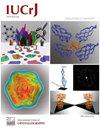三维电子衍射的多极化
IF 2.9
2区 材料科学
Q2 CHEMISTRY, MULTIDISCIPLINARY
引用次数: 0
摘要
30 多年前就有研究表明,原子间的结合对会聚束电子衍射图谱有明显的影响。Olech 等人的论文[(2024). IUCrJ, 11, 309-324]证明三维电子衍射数据中也明显存在这种影响,为量子晶体学开辟了新的可能性。本文章由计算机程序翻译,如有差异,请以英文原文为准。
3D electron diffraction goes multipolar
Over 30 years ago, it was shown that bonding between atoms has a noticeable effect on convergent beam electron diffraction patterns. The paper by Olech et al. [(2024). IUCrJ, 11, 309–324] demonstrates that its influence is also clearly present in 3D electron diffraction data, opening up new possibilities for quantum crystallography.
求助全文
通过发布文献求助,成功后即可免费获取论文全文。
去求助
来源期刊

IUCrJ
CHEMISTRY, MULTIDISCIPLINARYCRYSTALLOGRAPH-CRYSTALLOGRAPHY
CiteScore
7.50
自引率
5.10%
发文量
95
审稿时长
10 weeks
期刊介绍:
IUCrJ is a new fully open-access peer-reviewed journal from the International Union of Crystallography (IUCr).
The journal will publish high-profile articles on all aspects of the sciences and technologies supported by the IUCr via its commissions, including emerging fields where structural results underpin the science reported in the article. Our aim is to make IUCrJ the natural home for high-quality structural science results. Chemists, biologists, physicists and material scientists will be actively encouraged to report their structural studies in IUCrJ.
 求助内容:
求助内容: 应助结果提醒方式:
应助结果提醒方式:


